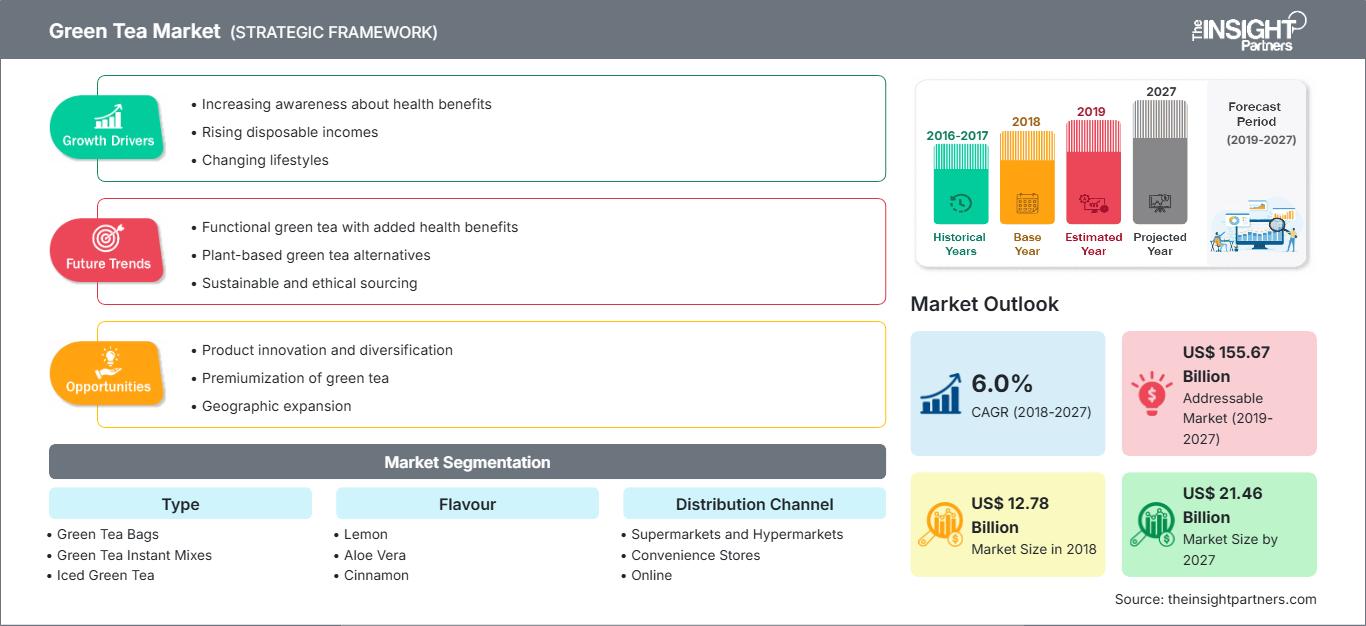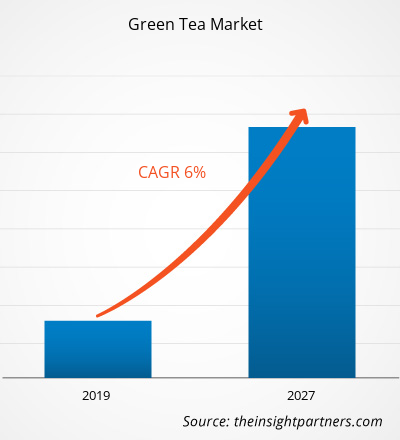El mercado del té verde se valoró en US$ 12.777,6 millones en 2018 y se espera que crezca a una CAGR del 6,0% entre 2019 y 2027 para alcanzar los US$ 21.456,2 millones en 2027.
El té verde se prepara a partir de la planta Camellia sinensis. Los brotes y las hojas secas de esta planta se utilizan para prepararlo. Se prepara friendo y cociendo al vapor las hojas, para luego secarlas. El té verde se produce generalmente mediante hidrólisis enzimática. Se sabe que el té verde es beneficioso contra diversos problemas de salud, como la depresión y diversos tipos de cáncer, como el de pulmón, hígado, colon y estómago, entre otros. Algunos estudios científicos también han demostrado que su consumo mejora la capacidad de razonamiento y ayuda a reducir el colesterol y los triglicéridos. En 2018, la región Asia-Pacífico ostentaba la mayor cuota de mercado mundial del té verde. Esta mayor cuota de mercado se atribuye principalmente a los cambios en los hábitos de vida de los consumidores y a su preferencia por productos alimenticios saludables y naturales. Se espera que la demanda de té verde aumente en la región debido a la creciente concienciación sobre sus beneficios para la salud. Los fabricantes de té verde están expandiendo sus actividades de producción en países desarrollados como China, India, Japón y Corea del Sur para satisfacer la creciente demanda de té verde en la región, lo que se espera que amplíe aún más el crecimiento del mercado del té verde en la región.
Personalice este informe según sus necesidades
Obtendrá personalización en cualquier informe, sin cargo, incluidas partes de este informe o análisis a nivel de país, paquete de datos de Excel, así como también grandes ofertas y descuentos para empresas emergentes y universidades.
Mercado del té verde: Perspectivas estratégicas

- Obtenga las principales tendencias clave del mercado de este informe.Esta muestra GRATUITA incluirá análisis de datos, desde tendencias del mercado hasta estimaciones y pronósticos.
Perspectivas del mercado
Los beneficios para la salud del té verde aromatizado están impactando el crecimiento del mercado del té verde.
Hoy en día, los consumidores de las regiones desarrolladas y en desarrollo son más conscientes de su salud. El té verde se elabora a partir de hojas y brotes de Camellia sinensis y no sufre marchitamiento ni oxidación. Se sabe que su consumo previene el cáncer, la cirrosis hepática, la obesidad, la presión arterial y muchas otras enfermedades crónicas. También ayuda a perder peso, ya que está compuesto por sustancias bioactivas, como la cafeína y los polifenoles, que contribuyen a la descomposición de las células grasas y su descarga al tracto circulatorio, lo que impulsa su demanda. Una bebida elaborada con té verde y limón ofrece numerosos beneficios para la salud, ya que posee diversas propiedades antiinflamatorias y antimicrobianas. Se dice que el té verde de aloe vera contiene nutrientes como aminoácidos, vitaminas, minerales, polisacáridos y enzimas. El té verde con canela ayuda a combatir trastornos estomacales y digestivos, y mejora la digestión al mejorar la capacidad del cuerpo para descomponer correctamente los alimentos y absorber los nutrientes de forma eficiente. El té verde con albahaca es útil para agudizar la memoria y reducir la ansiedad. El té verde de tulsi es rico en fitonutrientes y antioxidantes que ayudan a proteger el cuerpo contra los radicales libres. Se espera que la amplia gama de aplicaciones del té verde y el crecimiento constante de la cadena de suministro tengan un impacto positivo en el tamaño del mercado.
Información sobre tipos
El mercado del té verde, según su tipo, se divide en bolsitas, mezclas instantáneas, té verde helado, té de hojas sueltas y otros. El segmento de bolsitas representó la mayor participación en el mercado mundial. Además, se proyecta que el segmento de hojas sueltas mostrará un crecimiento significativo durante el período de pronóstico. Las bolsitas de té verde generalmente están hechas de papel de filtro, plástico apto para uso alimentario o algodón de seda. Están disponibles en diferentes sabores, como jengibre, menta y limón. Como las bolsitas son fáciles de transportar y se pueden preparar al instante, son muy populares en las zonas urbanas. Además, la creciente prominencia de sabores innovadores, únicos y étnicos en el té verde está aumentando la demanda de bolsitas de té verde en el mercado. El creciente uso de bolsitas de té verde tiene un impacto positivo en el tamaño del mercado.
Perspectivas sobre el sabor
El mercado del té verde se segmenta según su sabor, como limón, aloe vera, canela, vainilla, albahaca, entre otros. El mercado mundial del té verde, basado en su forma, fue liderado por el segmento de limón, que mantuvo la mayor participación de mercado. El té verde de limón contiene antioxidantes, flavonoides y otros fitonutrientes que ayudan a combatir diversas enfermedades crónicas y agudas. También está disponible en forma de té verde de limón helado. Agregar jugo de limón fresco al té verde también ayuda a aumentar sus propiedades medicinales y a mejorar su sabor. La combinación de té verde y jugo de limón produce una bebida rica en vitamina C, que tiene propiedades antiinflamatorias y antimicrobianas. También mejora la salud cardíaca y una piel radiante. El aroma relajante del té verde con sabor a limón es consumido por los consumidores por sus múltiples beneficios para la salud.
Información sobre el canal de distribución
Según el canal de distribución, el mercado global del té verde se clasifica en supermercados e hipermercados, tiendas de conveniencia, en línea y otros. En 2018, el segmento de supermercados e hipermercados lideró el mercado global del té verde. Los hipermercados y supermercados son tiendas de autoservicio que ofrecen una amplia variedad de productos de té verde, como mezclas de té verde y té verde helado, diferentes sabores de té verde, incluyendo albahaca, tulsi, miel, limón, etc. Esta amplia gama de productos se coloca de manera muy organizada en diferentes secciones y estantes para atraer a los clientes. Este tipo de tiendas ofrecen a los consumidores una amplia selección de productos de diferentes marcas en un solo lugar y a precios asequibles en comparación con otros canales de distribución. La amplia disponibilidad de productos de té verde de varias marcas a precios más bajos ha animado a los clientes a comprar té verde en hipermercados y supermercados.
Las empresas suelen adoptar diversas estrategias para expandir su presencia global, lo que repercute aún más en el tamaño del mercado. Los actores del mercado del té verde adoptan la estrategia de expansión e inversión en investigación y desarrollo para ampliar su base de clientes y ganar una cuota de mercado significativa a nivel mundial, lo que también les permite mantener su marca a nivel global.
Perspectivas regionales del mercado del té verde
Los analistas de The Insight Partners han explicado detalladamente las tendencias regionales y los factores que influyen en el mercado del té verde durante el período de pronóstico. Esta sección también analiza los segmentos y la geografía del mercado del té verde en Norteamérica, Europa, Asia Pacífico, Oriente Medio y África, y Sudamérica y Centroamérica.
Alcance del informe del mercado del té verde
| Atributo del informe | Detalles |
|---|---|
| Tamaño del mercado en 2018 | US$ 12.78 mil millones |
| Tamaño del mercado en 2027 | US$ 21.46 mil millones |
| CAGR global (2018-2027) | 6.0% |
| Datos históricos | 2016-2017 |
| Período de pronóstico | 2019-2027 |
| Segmentos cubiertos | Por tipo
|
| Regiones y países cubiertos | América del norte
|
| Líderes del mercado y perfiles de empresas clave |
|
Densidad de actores del mercado del té verde: comprensión de su impacto en la dinámica empresarial
El mercado del té verde está creciendo rápidamente, impulsado por la creciente demanda del consumidor final debido a factores como la evolución de las preferencias del consumidor, los avances tecnológicos y un mayor conocimiento de los beneficios del producto. A medida que aumenta la demanda, las empresas amplían su oferta, innovan para satisfacer las necesidades del consumidor y aprovechan las tendencias emergentes, lo que impulsa aún más el crecimiento del mercado.

- Obtenga una descripción general de los principales actores clave del mercado del té verde
Mercado mundial del té verde: por tipo
- Bolsitas de té verde
- Mezclas instantáneas de té verde
- Té verde helado
- Hojas sueltas
- Otros
Mercado mundial del té verde: por sabor
- Limón
- Aloe vera
- Canela
- Vainilla
- Albahaca
- Otros
Mercado mundial del té verde: por canal de distribución
- Supermercados e hipermercados
- Tiendas de conveniencia
- En línea
- Otros
Perfiles de empresas
- Compañía de bebidas AriZona
- Alimentos británicos asociados plc
- Compañía de té Dilmah Ceylon PLC.
- Finlays
- Té Hankook
- ITO EN
- Compañía Kirin Holdings Ltd.
- Nestlé SA
- Bebidas Tata Global
- Unilever
- Análisis histórico (2 años), año base, pronóstico (7 años) con CAGR
- Análisis PEST y FODA
- Tamaño del mercado, valor/volumen: global, regional y nacional
- Industria y panorama competitivo
- Conjunto de datos de Excel
Informes recientes
Informes relacionados
Testimonios
Razón para comprar
- Toma de decisiones informada
- Comprensión de la dinámica del mercado
- Análisis competitivo
- Información sobre clientes
- Pronósticos del mercado
- Mitigación de riesgos
- Planificación estratégica
- Justificación de la inversión
- Identificación de mercados emergentes
- Mejora de las estrategias de marketing
- Impulso de la eficiencia operativa
- Alineación con las tendencias regulatorias




















 Obtenga una muestra gratuita para - Mercado del té verde
Obtenga una muestra gratuita para - Mercado del té verde